Aquariums are an excellent hobby that can bring life to one’s home and help guests feel like they are entering a new world rarely seen by most eyes. Fish tanks range from simple individual bowls to complex multi-tank systems that are the house’s centerpiece.
Taking care of a fish tank is relatively simple, as long as you know how to change the water and properly maintain a proper cleaning schedule.
This article will teach you how often you should change the water in a fish tank and how to keep it clean to keep the fish healthy and the tank beautiful.
1. Changing the Fish Water Tank Frequency
A rule of thumb within the at-home aquarium community is to change the fish tank water every week or every two weeks. The frequency of changing the water will depend on two factors:
- Size of the tank
- How many fish are in the tank
2. Aquarium Size Factors
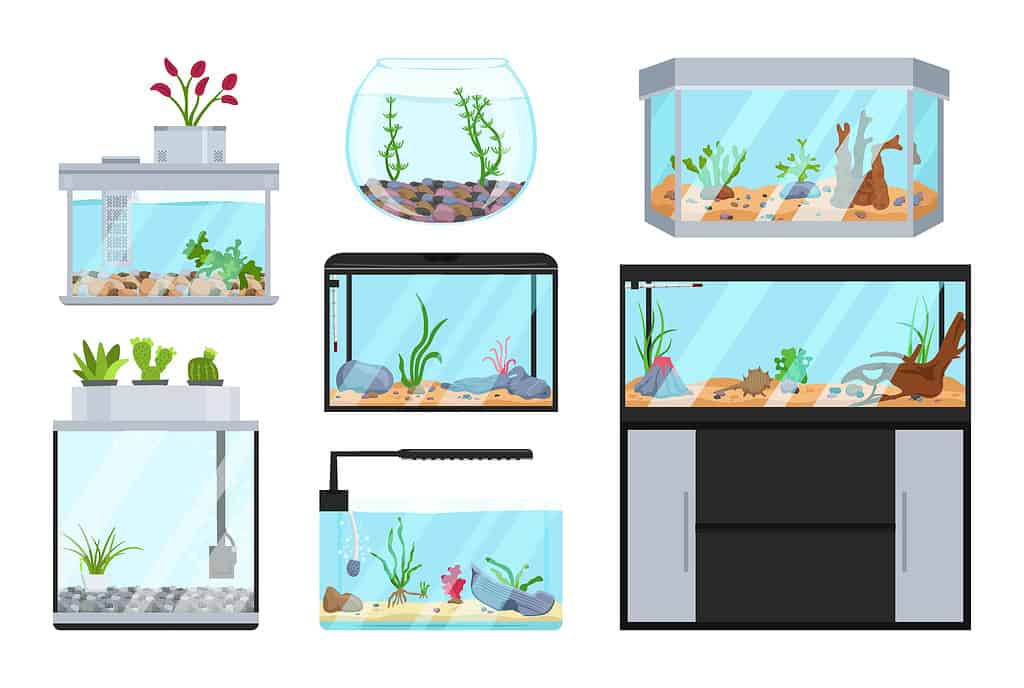
Fish tanks of varying sizes, shapes, and colors for any hobbyist to start or evolve their interest.
©newannyart/iStock via Getty Images
A small fish tank with only a few fish should have the water replaced once a week to ensure the fish are constantly swimming in a healthy environment.
A small fish tank with a lot of fish with a lot of fish will need to have the water changed once a week. The more crowded a fish tank is, the higher the chances the tank will become polluted with algae and nitrates released from feces and urine.
A medium to large tank with a few fish can have the water changed every two weeks. The larger tank provides plenty of space for the fish to roam freely and the filter to clean out excess debris.
A medium to large tank with multiple fish should have the water changed once a week. The larger tank size will provide more space for the fish, but there is more to balance with algae growth and nitrates.
3. How Much Water to Replace
Changing too much water too fast will harm the delicate ecosystem within the tank. Aquarium enthusiasts should replace 10-20% of the water in the tank every week or two weeks (again, depending on the size of the tank community).
Removing too much water can upset the pH balance to which the fish and plants are accustomed. If the pH levels are too high or too low, it can cause the fish to become ill or even die.
Performing partial water changes every week or two weeks is enough to keep the tank clean and well-balanced.
4. How To Change Fish Tank Water

While using a siphone to take out a small portion of water, use an algae scrub to clean the tank at the same time.
©Dmytro Varavin/iStock via Getty Images
Changing the water is a simple process by following these steps.
- First, turn off the filter and heater.
- Next, use a siphon tube and place one end at the top of the tank and another inside an empty bucket.
- Suck the end of the tube near the bucket to pull the water from the tank into the bucket.
- While the water is being siphoned, dip the tube toward the bottom of the tank to clean the gravel without pulling it through the tube.
- In the meantime, use an algae pad to scrape the side of the tank to remove any dirt and grime.
- Next, remove the filter from the tank and clean it out with the removed water. Then, replace any parts or pads by soaking them in the old water to remove any clean plastic chemicals and familiarize yourself with the new ecosystem.
- Pour out the old water and fill the bucket with fresh water.
- Add water conditioner or salt (if doing a saltwater tank) to balance the new water with the current tank. Use pH measures and salinity sticks to ensure the bucket levels match the tank.
- Stir the mixture together and pour the new water into the tank.
- Finally, turn on the filter and heater and close the top.
5. Benefits of Changing Aquarium Water
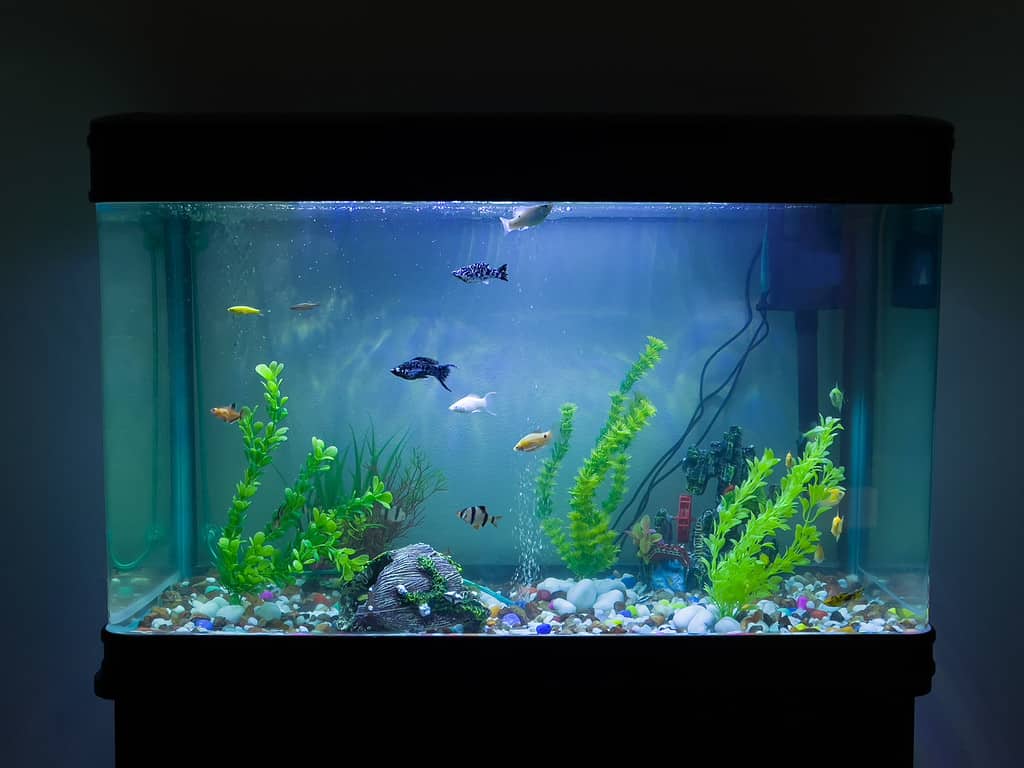
A clean fish tank looks aesthetically pleasing a provides a healthy environment for your fish.
©Malcolm/iStock via Getty Images
Changing the water is more than just a routine cleaning. The tank has a fragile micro-ecosystem that cleaning and moving the water helps keep in balance.
Removes Harmful Chemicals
Changing the water reduces the levels of nitrates and phosphates in the tank, which are naturally released when fish poop and pee. Most filters are not capable of removing these elements from the water. When there is too much nitrogen in the water, it will lead to sick or dead fish.
Supports Good Bacteria Growth
Good bacteria breaks down debris such as food and waste. Similar to how our stomachs have good bacteria to help us digest, there are good bacteria in the algae and water to keep the fish healthy. Adding new water helps promote good bacteria growth.
Natural rivers and lakes are constantly being replenished with new water from rainstorms. At-home aquariums do not have the same luxury of natural rain coming down, so it needs to be manually performed.
Improves Fish Health
Fish need a healthy balance of good bacteria, excellent water quality, oxygen, and food to survive well in the wild or in captivity. If one of these factors is off, then the fish may grow sick. Experienced fish hobbyists know when a fish is behaving weirdly and should be examined. New hobbyists will be lost as to why their fish are constantly sick or not growing to their full size.
Keeps Filter Clean
Filters are a great way to keep the tank clean on a daily basis. They remove larger bits of food, algae, or poop that float to the surface, reducing nitrogen and phosphate levels.
Not changing the water will overwhelm the filter as it is cycling through constantly dirty water. Filters need clean water to keep them functioning properly. Too much algae or grime will clog the filter, damage the pumps, and leave the tank looking dirty.
Aesthetically Pleasing
The best thing about having an aquarium is looking at the delightful fish and decorations on display. A clean tank looks more pleasing and relaxing than a dirty tank filled with algae, grime, and feces. It is a poor environment for the fish and unpleasant to see.
6. Cleaning the Aquarium Filter
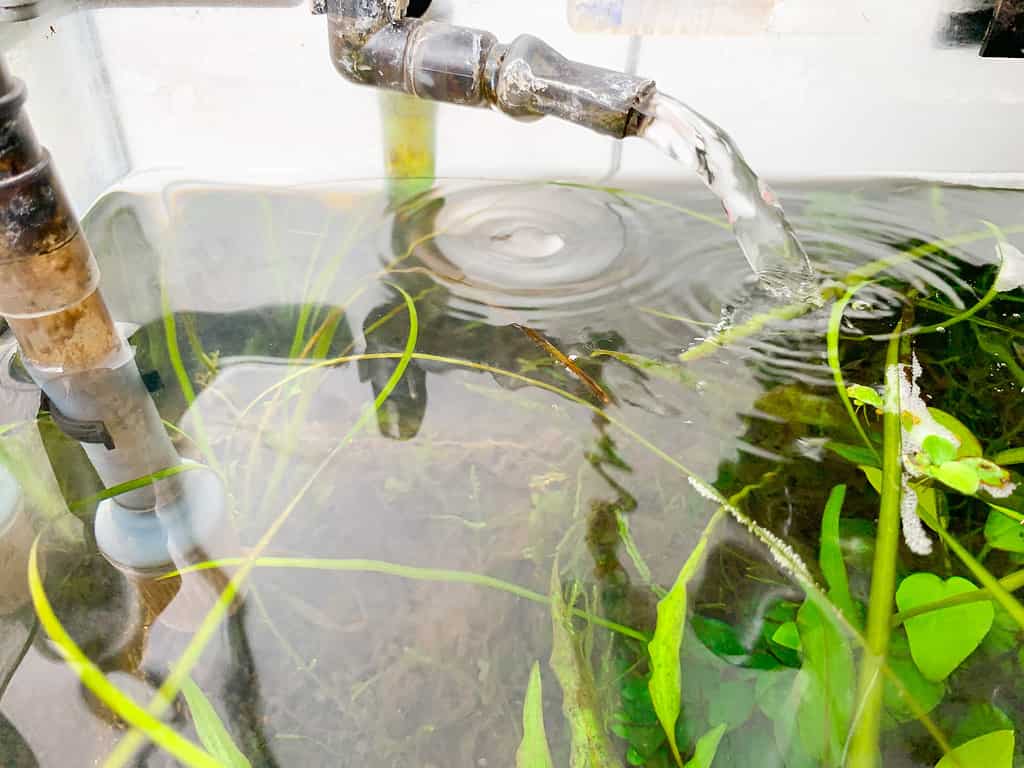
Aquarium water pump and filer to help oxygenate the water to keep the tank clean.
©Rizal Maulana Tirta/iStock via Getty Images
The aquarium filter is an important gadget that every fish tank should have. A common myth is that goldfish that are won at the fairs can survive anywhere, but they can survive much better and longer if they are given a proper tank with a dedicated filter to keep their home clean.
Use the old water from the fish tank to clean out the filter. Scrape out any algae and replace any parts or pads but soak them in the old water first so it has a better chance of acclimating to the microbiome of the aquarium.
7. Cleaning the Gravel
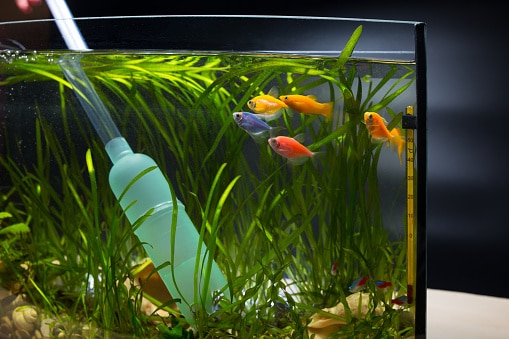
Siphons can be used to move the gravel and pick up algae buried underneath.
©Sergiy Akhundov/iStock via Getty Images
During the water changing and cleaning process, gravel should be siphoned up and cleaned at the same time. Using a siphon to drain water from the tank is simple and only takes a few minutes. While the water is being sucked out, use an aquarium vacuum to shuffle the gravel around and pick up any algae wedged between the bedding.
8. Aquarium Tank Care Tips
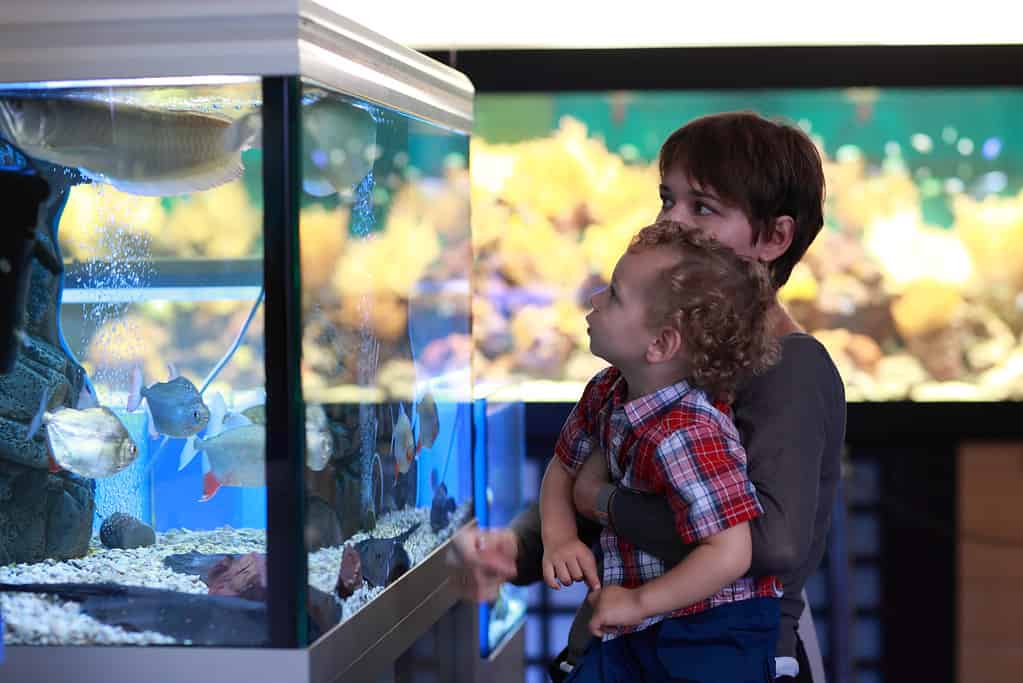
Fish tanks can be a fun family project where kids can offer advice on decoration while learning new animals.
©Radist/iStock via Getty Images
- Do not overcrowd the tank with too many fish.
- Allow the fish to feed for 5-10 minutes. Scoop out excess food to reduce stress on filter and algae growth.
- Do not remove the fish during the water replacement process.
- Always check the pH and temperature of fish tanks during cleaning and water replacement. Freshwater tank pH levels should be 6.6-6.8 with a temperature of 72-82 degrees Fahrenheit. Saltwater tank pH levels should be 7.6-8.4 with a temperature of 75-80 degrees Fahrenheit.
- Quickly remove any floating debris or grime to help keep the tank clean.
Aquariums are a beautiful hobby and a natural way of decorating the home differently. Fish are amazing creatures and having an aquarium is an excellent way of seeing them up close and understanding a world we rarely see.
FAQ
Why doesn’t the filter handle everything?
Filters are vital tools to keep the tank clean, but they cannot pick up the trace elements of nitrogen and phosphates that pollute the water. Filters also cannot pick up dirt buried within the gravel without risking harming the fish. Water changes are better for deep cleaning the tank.
How big of a tank do I need for fish?
A rule of thumb with aquariums is 1-inch fish = 1 gallon of water. The more fish you have, the more gallons of water they will need.
When should I make a full water change?
Never. There is no need to completely change the water in the tank. Consequently, performing a full water change can harm the fish since it is a dramatic change to the ecosystem they have grown accustomed to.
Do I have to do this with a goldfish bowl?
Yes. While Goldfish are strong fish, they will thrive better in a healthy environment with a dedicated filter, heater, and plants. Changing the water in a fish tank bowl has the same benefits as changing the water in a freshwater or saltwater tank.
Thank you for reading! Have some feedback for us? Contact the AZ Animals editorial team.








